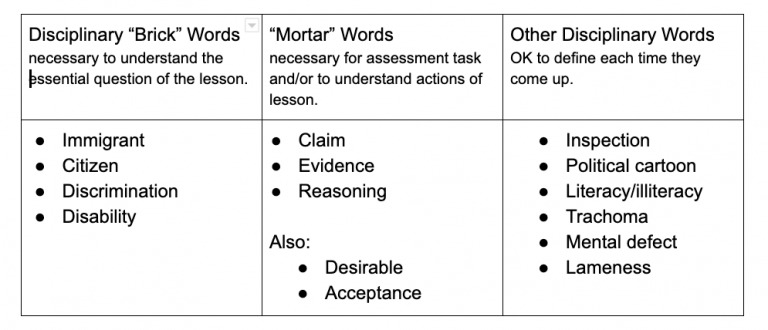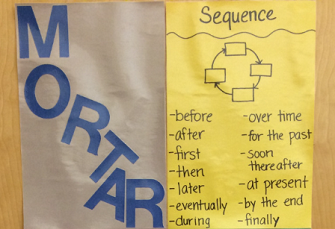“As of last year, I started working with ELL students and have become far more cognizant of vocabulary. I’ve always taken for granted that students know certain vocabulary words, but now I find myself going over many words and to my surprise, it’s not just ELL kids who benefit from it!”
-Kevin, Spring 2019 Online Accessing Inquiry course participant
Anticipating the needs of people who may encounter barriers benefits everyone. This is the truth behind Universal Design. Curb cuts at city street corners help not only people in wheelchairs, but people rolling suitcases, walking bicycles, and pushing strollers. Anticipating the vocabulary students need to fully participate in a lesson, and offering supports, can be just as broadly helpful.
History and Social Studies teachers know that in addition to the events of history, they teach the words that are necessary to understand history. Archaic words like pauper, seldom-used words like sovereign, abstract words like republicanism, and academic words like neolithic can pose barriers in both secondary and primary sources. The presence of unfamiliar or challenging words can be off-putting to students with a lower reading level, and the density of them in many social studies materials can be daunting regardless of reading level.
When teachers focus on making their lessons more accessible, vocabulary is an essential component. In Accessing Inquiry courses, teachers take many approaches to surmounting the barriers that vocabulary can pose. One is to identify Brick, Mortar, and Other words for a specific lesson.
Teachers winnow out the 3-5 words that all students need to know to master the essential facts and ideas in the lesson: these are the “Bricks”. These words may be basic or complex: they are not just the “hard” words, but the most vital words that are specific to the content of a lesson. These are words the teacher will review to make sure everyone understands before the lesson begins, and if needed, will reinforce throughout the lesson.
Teachers also identify “Other” disciplinary words that students will encounter in the lesson, words that the student needs to be able to access, but does not need to memorize or master. Teachers may copy text into a word-cloud-maker like http://WordSift.com to get a visual indicator of the most frequently used words in the central text for an upcoming lesson. One way or another, they consider in advance the words that students will encounter in the written and spoken elements of the lesson. In an accessible lesson, teachers often prepare a glossary, new section of a word wall, or other resource so that students can easily look up meanings and find a lesson-specific word when they need it for writing.
In pedagogy for teaching English Learners, the Mortar words in “Bricks and Mortar” are relational words: utility words that connect the “Brick” words in sentences. They include action words like “connect” and phrases like “even though.” As we use the term “Mortar” in the Accessing Inquiry course, we focus on words needed to connect the “bricks” in the student tasks for the lesson. Many of these words will be academic terms used across disciplines–including terms essential to take standardized tests. See for example this Academic Word List compiled by Averil Coxhead. If “Claim,” “Evidence,” and “Reasoning,” are words students must understand to complete a particular assessment, ensuring that those words are explained and understood is just as essential as the words related to the lesson topic.

In the illustrative example above, from the lesson by Alex Kuschel, In or Out: Race and Disability as Legal Barriers to Immigration, “mortar” words were matched to the assignment. The lesson asks each student to consider a fictional immigrant case study, and make an argument about whether or not he or she would have been admitted at Ellis Island. If students instead had been asked to draw an annotated picture imagining a scene at Ellis Island, the “mortar” words might have been “scene” and “annotated.”
Identifying the Bricks and Mortar vocabulary can focus a lesson. And, in addition to offering points of entry and making lessons less intimidating, review of the critical vocabulary in a lesson can enrich learning on many levels. As Kevin, the seasoned teacher quoted at the outset of this post, observed, until history teachers add vocabulary review into their lessons, they may not know every student who needs it. Like a curb cut, the added benefits reveal themselves only after it is in place.




